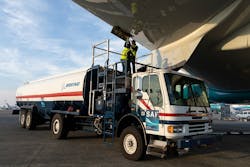Boeing doubling up Sustainable Aviation Fuel purchase this year
U.S. aircraft manufacturer Boeing has signed agreements with energy firms EPIC Fuels, Avfuel and Signature Aviation for the supply of blended sustainable aviation fuel (SAF) produced by Finnish renewable fuels producer Neste.
According to the airframer, the agreements cover a total supply of 5.6 million gallons of blended SAF to support its US commercial operations in 2023. This is more than double the amount of SAF it procured last year, Boeing says.
Under the purchase agreements, Neste MY Sustainable Aviation Fuel, which is mixed with conventional jet fuel at a 30/70 ratio to produce the blended SAF, will be supplied. Neste MY SAF is made from 100-percent renewable waste and residue raw materials, such as animal fat waste and cooking oil.
The Boeing ecoDemonstrator flight test program and the airframer’s commercial sites in Washington state and South Carolina will receive 2.3 million gallons from Signature Aviation and EPIC Fuels, with an additional 300,000 gallons supplied by Avfuel.
Boeing will also purchase an additional 3 million gallons of the same blended SAF from Signature Aviation and EPIC Fuels, generating emissions reduction credits for commercial deliveries, Dreamlifter and executive flights.
More on Sustainable Aviation Fuel in EnergyTech
Delta, Virgin Atlantic unite in deal to acquire 70M gallons of SAF
Fidelis to supply JetBlue with 92M gallons SAF
Subscribe to our free, tri-weekly newsletter for everyday insights into the C&I Energy Transition
Boeing says it committed to delivering commercial airplanes capable and certified to fly on 100-percent SAF by 2030. SAF can reduce CO2 emissions by up to 80-percent over the fuel's life cycle, with the potential to reach 100-percent in the future, making it a key technology for decarbonizing aviation over the next 20 to 30 years.
Made using several feedstocks, SAF is certified for commercial use and can currently be blended up to 50% with conventional jet fuel without the need for modifications to airplanes, engines or fueling infrastructure.
“We are demonstrating our commitment to reduce our carbon footprint and catalyze the SAF industry,” said Sheila Remes, Boeing vice president of Environmental Sustainability. “This SAF procurement makes up 25% of Boeing’s total jet fuel needs for last year including our production, delivery, Boeing ecoDemonstrator, and Dreamlifter flights, and we aim to increase that portion in the years to come.”
To support this goal, Boeing says it has achieved several key milestones, including the development of jet reference fluids to enable SAF compatibility testing and offering customers the option to power commercial delivery flights with SAF.
The aircraft manufacturer made initial SAF test flights in 2008, followed by approval for commercial SAF use in 2011 and airplane delivery flights in 2012.
The Boeing ecoDemonstrator made the first commercial airplane test flight using 100-percent SAF in both engines of a 777 Freighter in partnership with FedEx in 2018.
About the Author
EnergyTech Staff
Rod Walton is senior editor for EnergyTech.com. He has spent 17 years covering the energy industry as a newspaper and trade journalist.
Walton formerly was energy writer and business editor at the Tulsa World. Later, he spent six years covering the electricity power sector for Pennwell and Clarion Events. He joined Endeavor and EnergyTech in November 2021.
He can be reached at [email protected].
EnergyTech is focused on the mission critical and large-scale energy users and their sustainability and resiliency goals. These include the commercial and industrial sectors, as well as the military, universities, data centers and microgrids.
Many large-scale energy users such as Fortune 500 companies, and mission-critical users such as military bases, universities, healthcare facilities, public safety and data centers, shifting their energy priorities to reach net-zero carbon goals within the coming decades. These include plans for renewable energy power purchase agreements, but also on-site resiliency projects such as microgrids, combined heat and power, rooftop solar, energy storage, digitalization and building efficiency upgrades.
